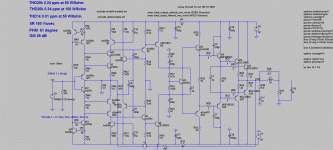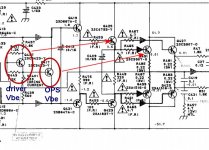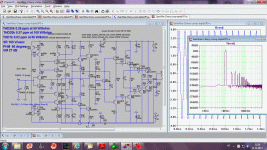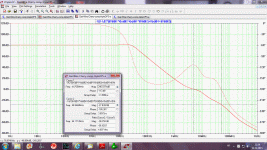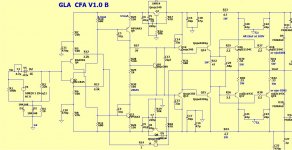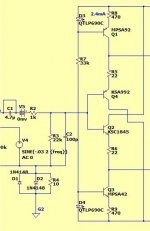Ostripper,,
what do the two 10Kohm resistors to GND around the VBE do..?? I would expect them to be a source of distortion.
I see the diamond is just another way to bias the input pair, an advantage here is that you just have one FB network.
IRL the tolerances of the two FB networks for the VSSA may be of greater damage than the input diamond, matter of tradeoff i guess
Also try to add a "cherry" nested FB to your circuit. maY lover your 20KHz distortion 10 times. (have not yet implemented it in real life but s working on something.🙂
(I have not any experience with output trippels so I am not sure if substituting the miller cap with cherry compensation will work without oscillation)
Those are 100k not 10k and better to connect middle point to the feedback input instead to the ground if you want lower LG.
I believe , if he did so, that he is wrong. It is just a VFA using a classical LTP with feedback impedance low enough to get rid of the FC due to base's parasitic capacitances.The author of the base design ...
A Paul Kemble web page - T Giesberts; HEXFET and IGBT amplifiers.
..descibes my amp as a CFA.
Also try to add a "cherry" nested FB to your circuit. maY lover your 20KHz distortion 10 times. (have not yet implemented it in real life but s working on something.🙂
(I have not any experience with output trippels so I am not sure if substituting the miller cap with cherry compensation will work without oscillation)
It should work. I showed it in here http://www.diyaudio.com/forums/solid-state/240712-cfa-topology-audio-amplifiers-213.html#post3714654 and here is improved compensation and no problem with square wave now.
Damir
Attachments
Your right , they increase THD.what do the two 10Kohm resistors to GND around the VBE do..?? I would expect them to be a source of distortion.
The study of my Sansui , my 2 harmon/kardons ... show they all
use this "technique" .
Some would say to go for the uber low THD.
Loading the VAS does change the residuals at the expense of THD. Whether
this is good or not is a point for contention.
Removing them does bring my last posted amp to .001% (all loads/levels/
20hz-20khz).
The triple is the BEST , award winning HK680 (below)... build that triple ,
have 20 years of a great sounding "party amp" .
Load it down with 2R subs (4 pair devices) , it will survive.
It's a compound Vbe - one device on the driver HS / the other on
the main HS .... 1mv from snowbank to heated house - Very accurate.
thermaltrak's are the only thing superior (H/K 990).
I own this triple - it is almost 20YO !! very durable/stable.
OS
Attachments
Member
Joined 2009
Paid Member
he is honest with himself and listen carefully.
An extremely rare trait, if it exists at all 😀
Hi Guys
Great work Dadod, ostripper and others, but...
How well do these amps perform at 1W?
Could never use 10W in my listening space let alone 100W.
Resistive loading of the VAS has been denounced by Self and others. Otala and other early designers used them to reduce low-frequency gain and presumably extend open-loop bandwidth in an attempt to scare away TIM. Leach had these Rs in his '76 amp, then removed them in the next and all following versions.
Using a resistive tap for feedback after drivers has also been denounced by Self - he likes to denounce things - as driver linearity may be questionable. However, many designs do so effectively.
Have fun
Kevin O'Connor
Great work Dadod, ostripper and others, but...
How well do these amps perform at 1W?
Could never use 10W in my listening space let alone 100W.
Resistive loading of the VAS has been denounced by Self and others. Otala and other early designers used them to reduce low-frequency gain and presumably extend open-loop bandwidth in an attempt to scare away TIM. Leach had these Rs in his '76 amp, then removed them in the next and all following versions.
Using a resistive tap for feedback after drivers has also been denounced by Self - he likes to denounce things - as driver linearity may be questionable. However, many designs do so effectively.
Have fun
Kevin O'Connor
How well do these amps perform at 1W?
For 1w , these CFA's (or my VFA's) , could drive a true class A OPS.
At 1w , even a typical multi-pair EF2/3 is always biased (class A).
OS
Hi Guys
Great work Dadod, ostripper and others, but...
How well do these amps perform at 1W?
Have fun
Kevin O'Connor
This is FFT at 10kHz and 1W.
This amp has flat loop gain of 80 dB up to 30 kHz(it uses local feedback from VAS output to the feedback input R52, R53).
Damir
Attachments
Don't worry: They will be class A all the way, distortion under noise level, noise under your listening floor unless you use 110db/W speakers.How well do these amps perform at 1W?
Hi Guys
Well, my speakers are 90dB for 1W at 1m.
I expect -160dB THD to be below the noise figure. Is there a noise estimate for this circuit?
One potential issue with the circuit in real life is that the SC3503/SA1381 pair are only available as gain ranges D and E respectively. These overlap slightly. Hopefully the circuit is not sensitive to the device betas in the positions you have used them in....
Have fun
Kevin O'Connor
Well, my speakers are 90dB for 1W at 1m.
I expect -160dB THD to be below the noise figure. Is there a noise estimate for this circuit?
One potential issue with the circuit in real life is that the SC3503/SA1381 pair are only available as gain ranges D and E respectively. These overlap slightly. Hopefully the circuit is not sensitive to the device betas in the positions you have used them in....
Have fun
Kevin O'Connor
Well, my speakers are 90dB for 1W at 1m.
That is not really sensitive ...
So are my Dayton 8" and tweeter (90.1db).
1W- I can hear them from 1-2 meters (near my PC)
My 50w z3900 sansui will fill the room.
For movies or "to startle (someone) 😀"
125W gives 113db on these speakers. Short peaks of close
to 117db are common for HD movies.
The 125W amp sounds almost the same as the 50W ,
except for more detailed sound (higher peaks).
But even as I usually listen at 2 M , 100W + is
nice for a multi-use system.
Elsewhere on DIYA , the tube/class A guys use 96-98db
super efficient drivers (with their "peanut" amps 😉 ).
PS -
One potential issue with the circuit in real life is that the SC3503/SA1381 pair are only available as gain ranges D and E respectively. These overlap slightly. Hopefully the circuit is not sensitive to the device betas in the positions you have used them in....
Ksa1220 AY and ksc2690 AY (160V/200+Hfe) are at mouser. These would work in a low to medium
rail voltage amp.
OS
Last edited:
The diamond front end is not from Hiraga. It's been described in professional literature in the 1970''s with the first commercially available devices from Comlinear.
First diamond circuits in the hifi market ?
Revox A740, 1978
Analyse du Revox A740
Hiraga classe A, may 1979
Ralisation d'un amplificateur classe A de 20W
The diamond concept (a complementary pair NPN-PNP of emitter followers biasind ans driving a seconde complementary pair PNP-NPN) was found in low power output stages by W. Jung. It was also used in the output stage of the first solid state power amp built by Audio Reseach.
serious problem with MOSFETs in a CFP output stage
If you overload the amp at HF, the gate caps charge up quickly but can only discharge slowly.
Quiescent Current rises quickly to extreme levels and the Holy Smoke escapes. 😱
Dunno about IGBTs.
There is a serious problem with using MOSFETs in a CFP output stage.
If you overload the amp at HF, the gate caps charge up quickly but can only discharge slowly.
Quiescent Current rises quickly to extreme levels and the Holy Smoke escapes. 😱
Dunno about IGBTs.
Member
Joined 2009
Paid Member
MOSFETs in a CFP output stage
Those are not CFP output amplifiers that I'm used to - the feedback from drain to driver emitter is usually local to each pair but in that design the local feedback is to a common point to both drivers.
Last edited:
MOSFETs in a CFP output stage
The problem is in both topologies. If you are going to try either, have your fire extinguisher ready.Those are not CFP output amplifiers that I'm used to - the feedback from drain to driver emitter is usually local to each pair but in that design the local feedback is to a common point to both drivers.
peeceebee
I "transplanted" the "peeceebee" into my previous posted circuit.
It seems to work in the same way as the diamond buffered -(CFA amp).
Current from OP goes through R12/13 , R5/6 and to ground through
C10/11 .... modulating the input pair emitter currents along the way.
My last circuits FB did the same with just 2 resistors ,modulating emitters
and passing directly to ground.
Slew , OLG , THD ... all the same. PSRR is worse , (the diamond had
current sources) ... but better than the original peeceebee (no cap
multipliers).
Could someone point out why this amp is a true CFA and the last one
was not ?
OS
I "transplanted" the "peeceebee" into my previous posted circuit.
It seems to work in the same way as the diamond buffered -(CFA amp).
Current from OP goes through R12/13 , R5/6 and to ground through
C10/11 .... modulating the input pair emitter currents along the way.
My last circuits FB did the same with just 2 resistors ,modulating emitters
and passing directly to ground.
Slew , OLG , THD ... all the same. PSRR is worse , (the diamond had
current sources) ... but better than the original peeceebee (no cap
multipliers).
Could someone point out why this amp is a true CFA and the last one
was not ?
OS
Attachments
I "transplanted" the "peeceebee" into my previous posted circuit.
It seems to work in the same way as the diamond buffered -(CFA amp).
Of course it works in the same way, even beter, tested soundwise. Your choice is not optimal, it should have positive and negative CCS as well, just like in VSSA, so better PSRR.
It should sound better since there's no buffer in front of the amp.
To fully understand what I'm trying to explain here, in practice please try to put attached buffer in front of any good amplifier, no matter VFA/CFA, and listen it in a system. There is clearly audible difference between with or without the out-of the feedback input buffer amplifier. In my system there's a clear difference if only input cables are changed, let alone the buffer.
Attachments
Diamond input buffer or not --- if any circuit does not fundamentally look like this --- it is not a CFA. Strictly speaking. Everything seems to get simplified or dumbed down.... so now we have anything with feedback of any kind to an emitter/source as a CFA.
Just to stay clear. There is a difference. When we go to simplify this further..... down to a minimalist circuit, we could end up with something else. But that can also be pretty good with care.
Thx-RNMarsh
View attachment 387052
Thanks Richard, basic model for truly DC coupled CFA is attached. Input pair biasing made by same base-emitter diodes like input pair has, no out-of the feedback buffer here. Basic model for exploring further.

Attachments
I love the L.C. designs from the first sight at one of his schematics. You know, like you like a painter more than an other... Then, it appeared that we had a lot of preferences in common. That's all.

- Home
- Amplifiers
- Solid State
- CFA Topology Audio Amplifiers
